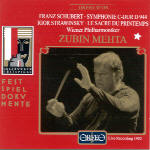What a magnificent tribute to a great orchestra (and consistently underrated conductor) this two-disc set represents! A program consisting of two large orchestral works, one of which is The Rite of Spring, challenges any ensemble. Solti and Chicago made a famous mess of Stravinsky’s masterpiece at a Carnegie Hall concert in the late 1980s, the first half of which consisted of Strauss’ Ein Heldenleben. Schubert’s Ninth isn’t any less taxing, in its way, though perhaps surprisingly Mehta’s and the VPO’s triumph is as complete in the Stravinsky as it is in the Schubert.
Looking at the VPO’s discography in these two works reveals an interesting fact: its previous recording of The Rite, under Maazel, also was very good, while the orchestra hasn’t really offered a first-rate Schubert Ninth since its outing with Kertesz in the early ’60s. Most of its subsequent recordings, including Solti’s, Muti’s, and especially Gardiner’s, have been pretty mediocre (while the most “Viennese” sounding of all, Krips on Decca, was actually made with the London Symphony). Mehta, on the other hand, recorded an excellent Ninth with the Israel Philharmonic for Decca, and has given us three top-notch Rites, one with Los Angeles (Decca) and two with New York (Sony and Teldec). So the combination of conductor, orchestra, and this repertoire actually makes good musical sense.
This particular Salzburg Festival concert, taped on August 21, 1985, opens with an incredible account of the Schubert. The forthright, very mezzo-forte opening horn call and swift tempo set the stage for a first movement characterized by shapely phrasing, muscular rhythms, and pungent accents (listen to the winds in the second subject). The Andante con moto, also swiftly paced, operates at an unbelievably high level of tension. Fabulously expressive solo winds in the first theme and warm strings in the second lead inexorably to a central cataclysm of epic proportions–but it’s all resolutely in tempo, never vulgar (trombones cut through the texture clearly but totally without coarseness), and a remarkable testimony to Mehta’s understanding of the movement’s architecture. The snappy scherzo benefits from far more precise ensemble than this orchestra often musters, while Mehta sustains the finale’s momentum with effortless grace, aptly saving the rhetorical emphasis for the coda’s four-note orchestral fist pounding–a brilliantly realized example of the “sublime grotesque” in music.
The Rite also makes a terrific impression. Mehta understands, as did Maazel, that you simply can’t expect this orchestra to execute some of the more dazzling brass and percussion effects with the same precision and commanding presence as, say, an American ensemble will. But within its characteristic “sound” the VPO plays the pants off the piece, with only a few tiny, totally insignificant slips along the way. Highlights include the very deliberate tempo that makes “Spring Rounds” compellingly evocative; the impressive orchestral clarity of “The Procession of the Sage” with its doleful Wagner tubas (as in his last New York recording, Mehta wisely has the tam-tam struck with a metal beater to clarify the polyrythmic texture); and a hugely exciting conclusion to Part One (okay, it’s not absolutely, perfectly together).
The quiet introduction to Part Two features some gorgeous chamber music textures from the VPO strings and culminates in a thrillingly fast and exciting final dance that increases in tension right up to the final bar. Mehta also clearly understands that quicker is safer when you can’t count on the metrical precision of, say, Boulez and Cleveland (Sony)–and my, how the Viennese abandon themselves to the spirit of the moment! Coming at the end of a very long day, their freshness and savagery at the conclusion of the piece really sets the seal on an amazing achievement, and as a live recording of The Rite this blows away the disgraceful recent Gergiev/Kirov effort on Philips.
The engineers of Austrian Radio have captured this event in the clearest, cleanest, most natural sound imaginable, with everything ideally balanced in an up-front perspective. There’s a fair amount of audience noise at the beginning of both works, but this isn’t too bothersome. In the Schubert’s slow movement, the silence gives the impression that the audience is holding its breath, spellbound. And so will you. For the best effect, listen to the whole concert at one sitting and treat yourself to a genuine musical event. [Editor’s Note: Qualiton is asking full price for this set, or approximately $35, but it’s a twofer in Europe, where it goes for about 17 Euros, or approximately $15, depending on your source.] [11/20/2001]
































